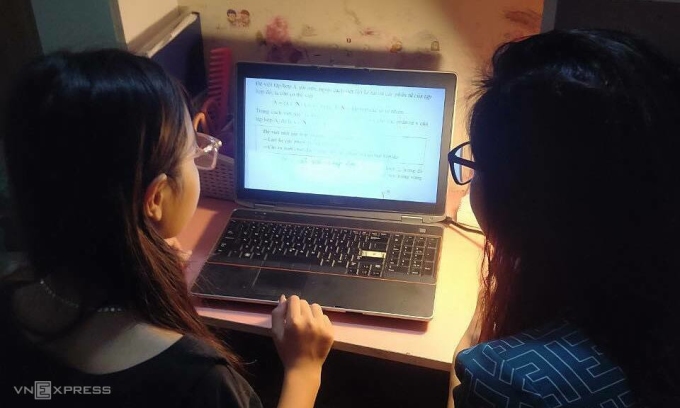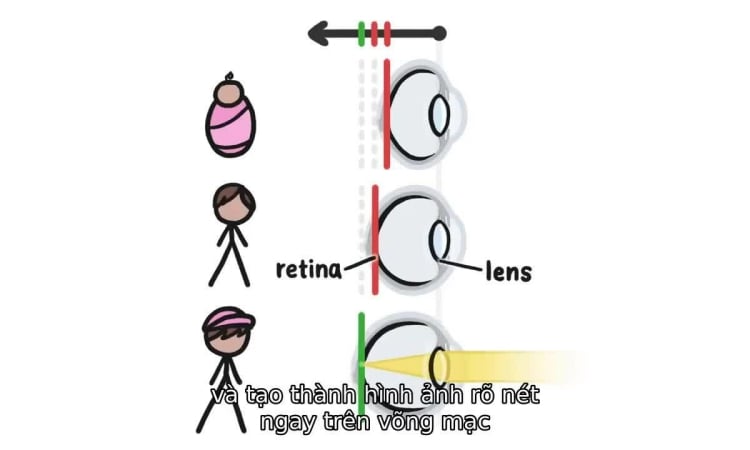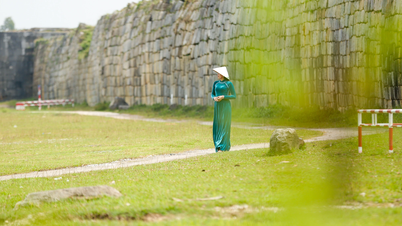In Hanoi, Ms. Loan, worried that her 8-year-old child had 7 degrees of nearsightedness and couldn't participate in extracurricular activities due to limited vision, reluctantly borrowed 150 million VND to treat her child's myopia.
"Despite our efforts to supplement medication and conduct regular check-ups, my child's eyesight continues to worsen. Treatment is not only mentally exhausting but also a financial struggle, as the debt keeps piling up," Ms. Loan said on June 15th.
Ms. Loan is an accountant at a furniture company in Hoai Duc district, earning approximately 15 million VND per month. One day at school, she noticed her daughter having to run very close to the blackboard to copy notes. Suspecting her daughter was nearsighted, she took her to the doctor, who diagnosed her with 4 degrees of myopia and advised monitoring to prevent the prescription from increasing too rapidly.
Back home, the couple bought eye supplements and took their child to many hospitals for checkups, "hoping only to keep the current degree of nearsightedness," but in less than a year, the child's prescription increased by three degrees. The child couldn't participate in sports activities due to poor eyesight, while wearing glasses was cumbersome. When it rained or was humid, the rising moisture further restricted vision. In class, few classmates were nearsighted, and being teased about having "one eye bulging and the other squinting" made the child even more self-conscious.
"Seeing our child so small, struggling to wear those heavy glasses, and being at a disadvantage compared to her friends in so many ways, made my husband and I anxious. We rushed to buy any medicine anyone suggested, but it didn't work," Ms. Loan said, adding that the monthly cost of eye exams, eye drops, and nutrition for the child amounts to two million dong.
Earlier this year, noticing her child's strabismus and progressively worsening vision in one eye, she discussed with her husband the possibility of taking out a high-interest loan to have their child undergo surgery to correct nearsightedness. Due to the child's thin cornea and high degree of nearsightedness, the doctor advised a new surgical method costing 100 million VND, not including additional expenses. Currently, after the surgery, the child still has to go to the hospital for vision therapy to correct the strabismus and must regularly use eye drops to prevent dryness and inflammation.
"The doctor said that even with eye surgery, my child still has a chance of becoming nearsighted again, so I honestly don't know if my decision was right or wrong," Ms. Loan said, adding that she is saving "every penny" to repay the 150 million VND loan.

Loan's daughter has severe nearsightedness, so she constantly monitors her, advising her to sit in the correct posture and avoid pressing her eyes too close to the screen to prevent her prescription from worsening. Photo: Nguyen Huyen
Linh, from Tay Ho district, has also struggled with wearing glasses for nearly 15 years. She said her family has visited many reputable hospitals and taken medication to treat her eyes, but her condition hasn't improved. Her most noticeable symptom is her bulging eyes due to wearing glasses for a long time, leading to teasing nicknames like "snail eyes" or "frog eyes." Furthermore, her high myopia combined with wearing glasses for extended periods has made her eyelids look dull and lifeless, causing her to avoid social interaction and stay indoors after school.
Following advice from many people, Linh's parents took her to several hospitals for eye surgery, costing between 90 million and 150 million VND. At private clinics, the amount could reach 200 million VND, including medication and post-operative care. "It felt like being lost in a maze because I didn't know which hospital to choose," Linh recounted.
However, after an examination at the Central Eye Hospital, the doctor concluded that her thin cornea was unsuitable for surgery, and advised her to increase her nutritional intake, take medication, and have regular check-ups. To this day, Linh, now 22 years old, still hasn't been able to undergo surgery, "but the cost of examinations and medication has already reached hundreds of millions of dong."
The World Health Organization (WHO) predicts that 50% of the global population is likely to be nearsighted by 2050. In Vietnam, the number of nearsighted cases has increased sharply in recent years, especially in urban areas. In major cities like Hanoi and Ho Chi Minh City, the rate of nearsightedness may reach 50-70% among students.
Dr. Nguyen Thi Xuan Loan, Deputy Head of the Ophthalmology Department at Thu Cuc TCI International General Hospital, stated that some of the main causes of myopia are genetics, environment, lifestyle habits, and wearing glasses with an incorrect prescription. Among these, environmental factors play a significant role as they directly cause and worsen myopia.
Myopia (nearsightedness) causes difficulties and inconvenience in daily activities, reduces the quality of life, and affects the psychological health of children. Children with myopia are at risk of serious visual impairment such as amblyopia due to not wearing glasses or wearing glasses with the wrong prescription. Severe myopia (over 6 diopters) can cause serious damage such as degeneration, cataracts, glaucoma, posterior vitreous detachment, retinal detachment, and blindness. Uncontrolled myopia can also place a burden on families due to high treatment costs and related health problems.
Young children are prone to nearsightedness. Video: Minute Earth
Currently, children with nearsightedness can wear glasses or undergo surgery. However, "there is no cure, and children still risk becoming nearsighted again, so the journey to recovery is very difficult," said Dr. Hoang Thanh Tung, Department of Ophthalmology, Hanoi Medical University Hospital.
Myopia surgery involves altering the surface of the eyeball (cornea) to change the refractive power of the cornea and replace the need for corrective lenses. After myopia surgery, protective measures for the eyes must still be maintained. Many cases require wearing glasses again after surgery, indicating that myopia has progressed to a more severe stage.
In addition, many people experience complications during and after surgery. Post-operative complications, in particular, can range from 10 types, making them quite complex to manage, and the resulting sequelae are significant. "Treating nearsightedness is difficult and expensive for many families. It's best for parents to pay close attention to their children to prevent or minimize the risk of refractive errors," Mr. Tung said.
Doctors recommend that children wear glasses with the correct prescription and monitor the progression of myopia. Limit close-up viewing and the use of digital devices such as phones, iPads, computers, and televisions. Increase outdoor activity, at least two hours a day and 10 hours a week. Supplement with foods containing carotenoids, zinc, xanthine, zexanythin, or eat red and yellow fruits.
To reduce eye strain, apply the 20-20-20 rule: after every 20 minutes of reading or looking at a screen, look at an object at least 6 meters away from your eyes for 20 seconds.
In addition, families should take their children to reputable clinics for examinations and avoid self-medication, overuse of drugs, or self-treating nearsightedness using unscientific folk remedies. Children should have their eyes checked regularly every three to six months to detect and correct vision problems promptly.
Early signs that can help detect nearsightedness in children include needing to read or watch television at close range, looking sideways, blinking, strabismus, squinting, and older children may complain of blurred vision.
Minh An - Nguyen Huyen
Source link














































































































Comment (0)